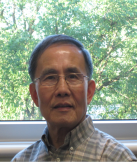报告题目:激光剑丝追未来
Filamentation into the future 时 间:2015年5月26日 10:00-12:00
地 点:武汉光电国家实验室A101
报 告 人:陈瑞良 教 授,加拿大拉瓦尔大学 Laval University
邀 请 人:陆培祥 教 授

报告人简介:
陈瑞良教授是著名加拿大华人学者,生于马来西亚,1964年毕业于台湾大学,获得物理学学士学位,1969年获得加拿大滑铁卢大学理学博士学位,博士毕业后长期在加拿大拉瓦尔大学工作,2001-2014年任加拿大超快强激光科学研究讲座教授(Canada Research Chair),2014年起任加拿大拉瓦尔大学荣休教授(Professor emeritus),2008年获得加拿大滑铁卢大学荣誉博士,1995年美国光学学会会士,2011年中国科学院上海光学精密机械研究所荣誉教授,2001年获得德国洪堡基金会最高的研究奖,2011年,获得加拿大物理学家协会最高奖--终身成就奖。
陈瑞良教授在他的整个职业生涯中,在强场激光物理领域取得了一系列的开创性和革命性的研究成果,这些成果在该领域产生了极其深远的影响。例如,他在实验上证实了原子分子的多光子电离效应,发现了多光子电离过程的饱和效应。1985年,他首次从实验上验证了隧穿电离理论,这一里程碑式的实验成果澄清了关于隧穿电离理论长期的质疑。隧穿电离最终开创了新的研究领域:高次谐波和阿秒科学。同时,陈教授在非线性光学新的分支--飞秒强激光成丝科学领域也取得了开创性的成果,推动了该领域的发展,他和几个国际同事一起引领着各种光学介质中飞秒强激光成丝的基础物理和应用研究向前发展。
陈瑞良教授在八十年代加拿大国家光学研究所(位于魁北克市)的创立过程中起到了关键性作用。现在,国家光学研究所已经是加拿大最大的应用光学和工业光学研究中心。 Biography:
Throughout his career, Prof. See Leang Chin carried out pioneering and innovative research in strong laser field physics that profoundly impacted the field. Starting with the confirmation of multiphoton ionization (MPI) of atoms and molecules and the discovery of saturation during MPI, he experimentally proved the validity of tunnel ionization beyond doubt in 1985. Tunnel ionization eventually opened up a whole new world of physics, namely, high harmonic generation and attosecond science.
Prof. Chin is also known for pioneering the development of a new branch of nonlinear optics, namely, intense femtosecond laser filamentation. He led the way, together with a few colleagues, in the fundamental understanding of the physics and applications of filamentation of ultrashort intense laser pulses in various optical media.
Prof. Chin played a key role in the 1980’s in the creation of National Optics Institute in Quebec City, Canada. NOI is now the largest applied and industrial optics research center in Canada.
B.Sc. in physics from National Taiwan University (1964), Ph.D. in physics from the University of Waterloo, Canada (1969), Prof. Chin worked in Laval University since his graduation. He was a Canada Research Chair in ultrafast intense laser science 2001-2014. He is Professor Emeritus of Laval University since 2014. He received an honorary D.Sc. degree from the University of Waterloo, Canada in 2008. He is a fellow of the Optical Society OSA and an honorary professor of SIOM. The Humboldt Research Foundation in Germany honored him with the highest research award in 2001. In 2011, he was honored with the top prize of the Canadian Association of Physicists, namely, the Medal of Lifetime Achievement in Physics.
报告摘要:
飞秒激光成丝现象已经开创了从纯物理到应用研究的许多新的科学研究领域,其中包括源于量子和经典物理的多个应用研究。飞秒光丝中的新现象,例如,激光强度钳制效应、空气激光、粒子数捕获、分子排列、分子超激发态、光丝诱导降雪、光丝化学等等,开辟了令人振奋的、多学科交叉新领域。
激光强度钳制效应是一个复杂的物理现象,结果可以形成一个非常稳定相互作用状态。粒子数束缚、分子排列、转动及其周期性可被用于脉冲太赫兹辐射的远程探测。光丝中的空气激光现象看起来像是一种新的激发机制,例如,光丝中激光强度可以把氮气和二氧化碳分子激发到一种粒子数反转的状态。与此同时,这种光丝诱导激光现象(或粒子数反转)在空气中“污染分子”形成的分子碎片中也被观察到。利用单一激光,通过探测特征荧光来远程识别污染物、气体或者固体样品已经至少在原理上得到证实。光丝诱导沉积现象已经在云室中变成现实。最后将要讨论一下光丝研究领域未来的挑战以及光丝化学为光丝研究提供的一个新的机遇。 Abstract:
Femtosecond laser filamentation has opened up many frontiers of science, both pure and applied. It encompasses applications due to both quantum and classical physics. Phenomena such as Intensity clamping, lasing in air and in pollutants, population trapping, molecular alignment, super-excitation of molecules, filament induced snow fall, filamentation chemistry, etc. open up a new stimulating multidisciplinary playground.
Intensity clamping is a profound phenomenon which could lead to very stable interaction consequences. Population trapping and molecular alignment, rotation and revival can be applied to remote detection of pulsed THz radiation. Lasing in an air filament seems to rely upon a new scheme of exciting a simple molecule such as N2 and CO2 into a state of population inversion. Lasing (or population inversion) from fragmented pollutant molecules inside an air filament was observed. The characteristic fluorescence from many pollutants, gaseous or solid could be detected remotely using only one laser, at least in principle. Filament induced precipitation inside a cloud chamber becomes a reality. Challenges in the future will be discussed at the end. Filamentation chemistry is a promising new direction for application. |